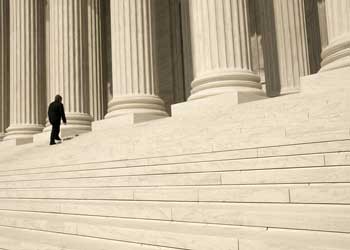
California Supreme Court Decides Hot-Topic in Trusts with Barefoot v. Jennings
The California Supreme Court has issued the eagerly-awaited opinion in Barefoot v. Jennings (January 23, 2020, S251574) __ Cal.5th __ [240 Cal.Rptr.3d 702, 430 P.3d 1178]. Justice Chin authored the unanimous opinion. After percolating statewide since 2018, the recent decision hit close to home with Bay Area probate litigators for two reasons. First, the holding circumscribed a pivotal issue on standing in trust proceedings. Second, Nathan Pastor, a budding second-generation Contra Costa lawyer and CCCBA member, shined with his winning oral argument.
A typical set of facts prompted the proceeding. A settlor amended her revocable trust shortly before she died. The amendment disinherited the settlor’s daughter. The daughter challenged the validity of the amendment on the bases of incapacity, undue influence, and fraud.
The defendants moved for dismissal of the challenge based on the daughter’s lack of standing. (See Barefoot v. Jennings (2018) 27 Cal.App.5th 1, 6, revd. (January 23, 2020, S251574) __ Cal.5th __.) The defendants relied on Probate Code section 17200, subdivision (a). That section states: “a trustee or beneficiary of a trust may petition the court under this chapter concerning the internal affairs of the trust or to determine the existence of a trust.” The defendants argued a myopically-literal reading of the statute and prefaced the plain language with an implied “only.”
The Court of Appeal, Fifth Appellate District, thus held that “only a beneficiary or trustee of a trust can file a petition under section 17200.” (See Barefoot v. Jennings (2018), supra, 27 Cal.App.5th at 6, rev’d.) Because the settlor’s daughter was no longer named as beneficiary or trustee in the last-amended version of the trust, she lacked standing to challenge the validity of the very instrument that eliminated her interest pursuant to section 17200. “Who better,” queried trust litigators, “to have standing to contest a trust than a former beneficiary disinherited by an allegedly invalid amendment?”
Such a limited interpretation of the statute frustrated “the primary duty of a court in construing a trust [which] is to give effect to the settlor’s intentions.” (Barefoot v. Jennings (2020), supra, at 4, citing Brock v. Hall (1949) 33 Cal.2d 885.) Rather than “[p]romot[ing] the public interest in preventing the administration of trust property that is procured through fraud or undue influence,” the appellate court’s ruling precluded challenges pursuant to Probate Code section 17200 by alleged beneficiaries whose interests may have been wrongfully eliminated by a subsequent amendment. (See Barefoot v. Jennings (2020), supra, at 7, fn. 3.)
The Supreme Court, accordingly, reversed the judgment of the Court of Appeal and remanded the matter. In so doing, the Supreme Court iterated the wide latitude of the probate court to determine all controversies and incidental issues between trustees and those claiming to be beneficiaries under a trust. (Id. at 5–8.)
The Supreme Court thus provided an “orderly and expeditious mechanism for limited challenges like plaintiff’s to be litigated early in the probate process, in probate court, and to ensure that the settlor’s intent is honored.” (Id. at 8, citing Brock v. Hall, supra, 33 Cal.2d at 885.) On a motion to dismiss, the court must first determine standing by treating the properly pled allegations as true, i.e., that invalidating the challenged provisions or amendments would render the plaintiff a beneficiary of the trust. If, based on the allegations of the petition, the plaintiff has a present or future interest, then the plaintiff is a beneficiary permitted to petition the probate court pursuant to section 17200.
To hold otherwise “would be to insulate those persons who improperly manipulate a trust settlor to benefit themselves against a probate petition.” (Id. at 8.) Converging practice, form, and substance, the Supreme Court solidified the foundation on which claimed beneficiaries have tread to stand.